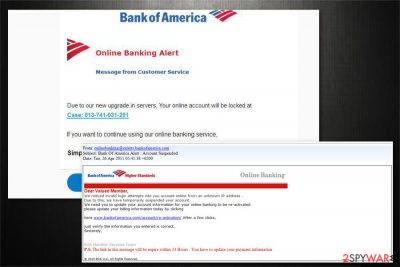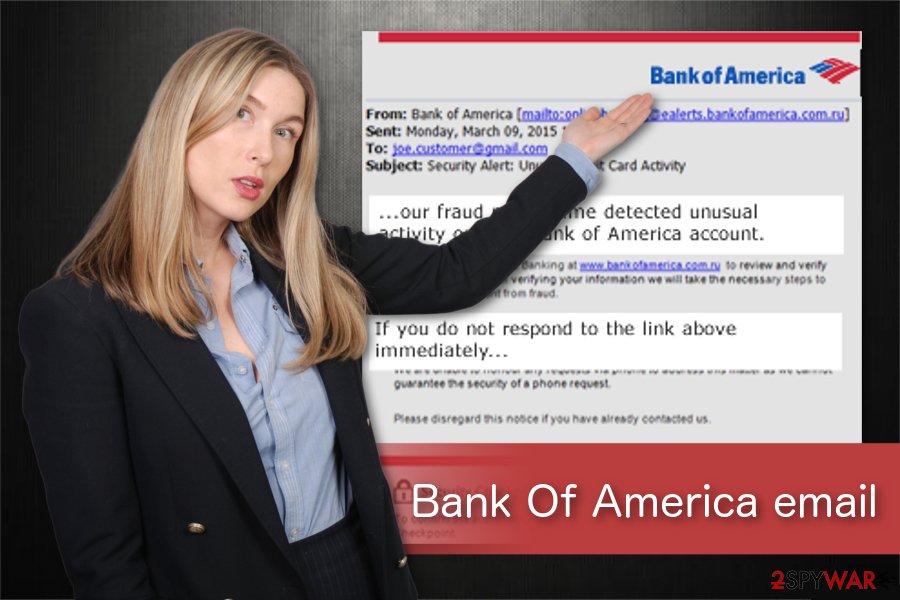Bank Of America email virus (Removal Instructions) - Simple Removal Guide
Bank Of America email virus Removal Guide
What is Bank Of America email virus?
Bank Of America email virus is a pesky cyber threat which aims to collect private users' data for cybercriminals

Bank Of America email is a virus which spreads via malspam campaigns and impersonates a legitimate financial services company. The deceptive emails claim to come from the multinational investment bank and recommend users to update their account details, or they will not be able to log in shortly. However, the electronic letters from Bank Of America email virus are fake and designed to trick unsuspecting people into providing personal information for the hackers.
| Name | Bank Of America email virus |
|---|---|
| Type | Malware |
| Danger level | High. Can lead to financial losses |
| Symptoms | Users receive fake emails asking to update their bank account details via the provided link |
| Distribution | Malspam campaigns |
| Potential dangers | The indicated link can either lead to spoof login sites where sensitive data is sent to criminals or trigger an automatic installation of malware |
| Removal | If you have received the fraudulent email and clicked on its content, we advise you to scan your PC files with FortectIntego and uninstall Bank Of America email virus |
Users report that one of the most common tactics employed by Bank Of America email virus is to claim that the investment bank has upgraded their servers and users' accounts will be locked. Likewise, people are encouraged to click on the indicated link below the message to update their details. However, this is merely a trick to lure people into unconsciously providing their private data for the criminals.
Note that other emails coming from Bank Of America email virus inform about an unauthorized attempt to login to user's account and claim that it was temporarily suspended. People are asked to update their details as well to re-activate the account. Unfortunately, both of these malicious emails are fake and are not related to the legitimate financial services company in any way.
Keep in mind that clicking on the link provided by Bank Of America email virus, you risk exposing sensitive data to the criminals. Usually, hackers create spoof websites which look similar to the official online bank page and display the login window. However, once the user supposedly logins, all the entered data is sent to the cybercriminals.

Therefore, it is essential to avoid clicking on any content provided in the malicious email. In fact, you should delete it without opening immediately. Although, if you have accidentally clicked on the link or were tricked to submit your login details, you should think about Bank Of America email virus removal right away.
Be aware that Bank Of America email virus can help infiltrate the system with more potentially dangerous cyber threats, including the following:
- Banking Trojans;
- Spyware[1];
- Keyloggers;
- Etc.
All of these malicious programs are designed to monitor user's activity, record it and sent to remote attackers. Likewise, you should be extremely vigilant and remove Bank Of America email virus if you have been infected. For that, we suggest using reliable security tools, like FortectIntego.
Tips to protect yourself from phishing emails
Malware and other dangerous cyber threats are distributed via well-designed spam emails. Usually, the electronic letter contains the company's logo, formal language and a feel of legitimacy. However, cybercriminals work hard to make the malicious emails convincing in order to spread the infections worldwide.
Luckily, cybersecurity experts have several tips which can help you identify a phishing email and protect yourself from scams[2]:
- Check the email address from which the message was sent — it should look suspicious and include unnecessary words, like BankofAmericaOnlineAlerts@Intl.com;
- Try placing the cursor on the link in the email, it should reveal the domain to which you will be redirected; If it's not the official bank site, do not click on it;
- In case the email claims that your account is suspended, you can open a new tab and try signing in through the official page. If it works, the message is fake;
- You can always contact the bank directly and ask to confirm the email.
Safe ways to get rid of Bank Of America email virus
Since cybercriminals are getting more advanced, their malicious programs are becoming more sophisticated as well. If you have been infected with malware and want to remove Bank Of America email virus, you should remember that cyber threats consist of numerous components.
Complete Bank Of America email virus removal requires you to uninstall each and every piece of the malware to protect your system. Note that usually, hackers name malicious files under the names of legitimate system processes to confuse unsuspecting computer users.
If you want to avoid potential damage and uninstall Bank Of America email virus safely, researchers[3] say that you should get professional security tools to help you. Our top choices are FortectIntego, SpyHunter 5Combo Cleaner, and Malwarebytes as they are easy-to-use and robust enough to deal with various cyber threats.
Getting rid of Bank Of America email virus. Follow these steps
Manual removal using Safe Mode
Rebooting your computer into Safe Mode with Networking can help you deactivate the virus:
Important! →
Manual removal guide might be too complicated for regular computer users. It requires advanced IT knowledge to be performed correctly (if vital system files are removed or damaged, it might result in full Windows compromise), and it also might take hours to complete. Therefore, we highly advise using the automatic method provided above instead.
Step 1. Access Safe Mode with Networking
Manual malware removal should be best performed in the Safe Mode environment.
Windows 7 / Vista / XP
- Click Start > Shutdown > Restart > OK.
- When your computer becomes active, start pressing F8 button (if that does not work, try F2, F12, Del, etc. – it all depends on your motherboard model) multiple times until you see the Advanced Boot Options window.
- Select Safe Mode with Networking from the list.

Windows 10 / Windows 8
- Right-click on Start button and select Settings.

- Scroll down to pick Update & Security.

- On the left side of the window, pick Recovery.
- Now scroll down to find Advanced Startup section.
- Click Restart now.

- Select Troubleshoot.

- Go to Advanced options.

- Select Startup Settings.

- Press Restart.
- Now press 5 or click 5) Enable Safe Mode with Networking.

Step 2. Shut down suspicious processes
Windows Task Manager is a useful tool that shows all the processes running in the background. If malware is running a process, you need to shut it down:
- Press Ctrl + Shift + Esc on your keyboard to open Windows Task Manager.
- Click on More details.

- Scroll down to Background processes section, and look for anything suspicious.
- Right-click and select Open file location.

- Go back to the process, right-click and pick End Task.

- Delete the contents of the malicious folder.
Step 3. Check program Startup
- Press Ctrl + Shift + Esc on your keyboard to open Windows Task Manager.
- Go to Startup tab.
- Right-click on the suspicious program and pick Disable.

Step 4. Delete virus files
Malware-related files can be found in various places within your computer. Here are instructions that could help you find them:
- Type in Disk Cleanup in Windows search and press Enter.

- Select the drive you want to clean (C: is your main drive by default and is likely to be the one that has malicious files in).
- Scroll through the Files to delete list and select the following:
Temporary Internet Files
Downloads
Recycle Bin
Temporary files - Pick Clean up system files.

- You can also look for other malicious files hidden in the following folders (type these entries in Windows Search and press Enter):
%AppData%
%LocalAppData%
%ProgramData%
%WinDir%
After you are finished, reboot the PC in normal mode.
Remove Bank Of America email using System Restore
-
Step 1: Reboot your computer to Safe Mode with Command Prompt
Windows 7 / Vista / XP- Click Start → Shutdown → Restart → OK.
- When your computer becomes active, start pressing F8 multiple times until you see the Advanced Boot Options window.
-
Select Command Prompt from the list

Windows 10 / Windows 8- Press the Power button at the Windows login screen. Now press and hold Shift, which is on your keyboard, and click Restart..
- Now select Troubleshoot → Advanced options → Startup Settings and finally press Restart.
-
Once your computer becomes active, select Enable Safe Mode with Command Prompt in Startup Settings window.

-
Step 2: Restore your system files and settings
-
Once the Command Prompt window shows up, enter cd restore and click Enter.

-
Now type rstrui.exe and press Enter again..

-
When a new window shows up, click Next and select your restore point that is prior the infiltration of Bank Of America email. After doing that, click Next.


-
Now click Yes to start system restore.

-
Once the Command Prompt window shows up, enter cd restore and click Enter.
Finally, you should always think about the protection of crypto-ransomwares. In order to protect your computer from Bank Of America email and other ransomwares, use a reputable anti-spyware, such as FortectIntego, SpyHunter 5Combo Cleaner or Malwarebytes
How to prevent from getting malware
Access your website securely from any location
When you work on the domain, site, blog, or different project that requires constant management, content creation, or coding, you may need to connect to the server and content management service more often. The best solution for creating a tighter network could be a dedicated/fixed IP address.
If you make your IP address static and set to your device, you can connect to the CMS from any location and do not create any additional issues for the server or network manager that needs to monitor connections and activities. VPN software providers like Private Internet Access can help you with such settings and offer the option to control the online reputation and manage projects easily from any part of the world.
Recover files after data-affecting malware attacks
While much of the data can be accidentally deleted due to various reasons, malware is one of the main culprits that can cause loss of pictures, documents, videos, and other important files. More serious malware infections lead to significant data loss when your documents, system files, and images get encrypted. In particular, ransomware is is a type of malware that focuses on such functions, so your files become useless without an ability to access them.
Even though there is little to no possibility to recover after file-locking threats, some applications have features for data recovery in the system. In some cases, Data Recovery Pro can also help to recover at least some portion of your data after data-locking virus infection or general cyber infection.





















